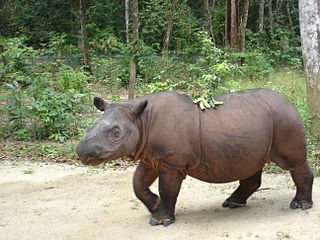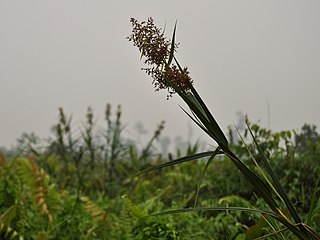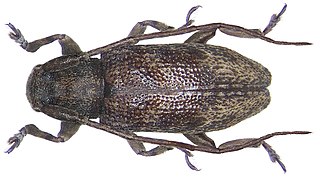
The Sumatran rhinoceros, also known as the hairy rhinoceros or Asian two-horned rhinoceros, is a rare member of the family Rhinocerotidae and one of five extant species of rhinoceros. It is the only extant species of the genus Dicerorhinus. It is the smallest rhinoceros, although it is still a large mammal; it stands 112–145 cm (3.67–4.76 ft) high at the shoulder, with a head-and-body length of 2.36–3.18 m (7.7–10.4 ft) and a tail of 35–70 cm (14–28 in). The weight is reported to range from 500 to 1,000 kg, averaging 700–800 kg (1,540–1,760 lb), although there is a single record of a 2,000 kg (4,410 lb) specimen. Like both African species, it has two horns; the larger is the nasal horn, typically 15–25 cm (5.9–9.8 in), while the other horn is typically a stub. A coat of reddish-brown hair covers most of the Sumatran rhino's body.

Dicerorhinus is a genus of the family Rhinocerotidae, consisting of a single extant species, the two-horned Sumatran rhinoceros, and several extinct species. The genus likely originated in the Mid to Late Pliocene of Northern Indochina and South China. Many species attributed to the genus probably actually belong in Stephanorhinus.

Erigeron sumatrensis is an annual herb probably native to South America, but widely naturalised in tropical and subtropical regions, and regarded as an invasive weed in many places. In the British Isles it is known as Guernsey fleabane. Other common names include fleabane, tall fleabane, broad-leaved fleabane, white horseweed, and Sumatran fleabane.

Rhizomys is a genus of rodents in the family Spalacidae. They are all stocky burrowers with short, naked tails. Rhizomys contains these species:

The large bamboo rat, Sumatran rat, or Indomalayan rat is a species of rodent in the family Spalacidae found in Cambodia, China, Indonesia, Laos, Malaysia, Myanmar, Thailand, and Vietnam. It is one of four species of bamboo rat. Individuals can reach lengths of nearly 50 cm (20 in) with a 20 cm (7.9 in) tail, and weigh up to 4 kilograms (8.8 lb).

Ropica Górna is a village in the administrative district of Gmina Sękowa, within Gorlice County, Lesser Poland Voivodeship, in southern Poland, close to the border with Slovakia. It lies approximately 4 kilometres (2 mi) east of Sękowa, 9 km (6 mi) south-east of Gorlice, and 108 km (67 mi) south-east of the regional capital Kraków.

Scleria sumatrensis, commonly known as nutrush and Sumatran scleria, is a plant species in the sedge family. It is native to temperate and tropical Asia, where it is usually found growing in wetlands, and is considered a noxious weed on the island of Borneo. It has been used in traditional medicine against gonorrhea.

Filopaludina sumatrensis is a species of large freshwater snail with a gill and an operculum, an aquatic gastropod mollusk in the family Viviparidae.

Ropica is a genus of beetles in the family Cerambycidae, containing the following species:

The Northern Sumatran rhinoceros, also known as Chittagong rhinoceros or northern hairy rhinoceros was the most widespread subspecies of Sumatran rhinoceros, as well as the only known subspecies native to mainland Asia.
Ropica albomarmorata is a species of beetle in the family Cerambycidae. It was described by Breuning in 1939.
Ropica marmorata is a species of beetle in the family Cerambycidae. It was described by Breuning in 1939. It contains the subspecies Ropica marmorata marmorata and Ropica marmorata sarawakiana.
Ropica principis is a species of beetle in the family Cerambycidae. It was described by Breuning in 1939.
Ropica kaszabi is a species of beetle in the family Cerambycidae. It was described by Breuning in 1975.
Ropica sechellarum is a species of beetle in the family Cerambycidae. It was described by Breuning in 1957. It contains the subspecies Ropica sechellarum interruptefasciata and Ropica sechellarum sechellarum.

Ropica indigna is a species of beetle in the family Cerambycidae. It was described by Pascoe in 1865.
Ropica duboisi is a species of beetle in the family Cerambycidae. It was described by Fairmaire in 1850.
Ropica formosana is a species of beetle in the family Cerambycidae. It was described by Henry Walter Bates in 1866. It contains four subspecies, Ropica formosana formosana, Ropica formosana japonica, Ropica formosana nobuoi, and Ropica formosana tokaraensis.
Obereopsis sumatrensis is a species of beetle in the family Cerambycidae. It was described by Stephan von Breuning in 1951.

The Indochinese blue flycatcher is a species of bird in the family Muscicapidae. It is found from southern Myanmar and the Malay Peninsula to Indochina and northeastern Sumatra. It was previously considered conspecific with Tickell's blue flycatcher.










